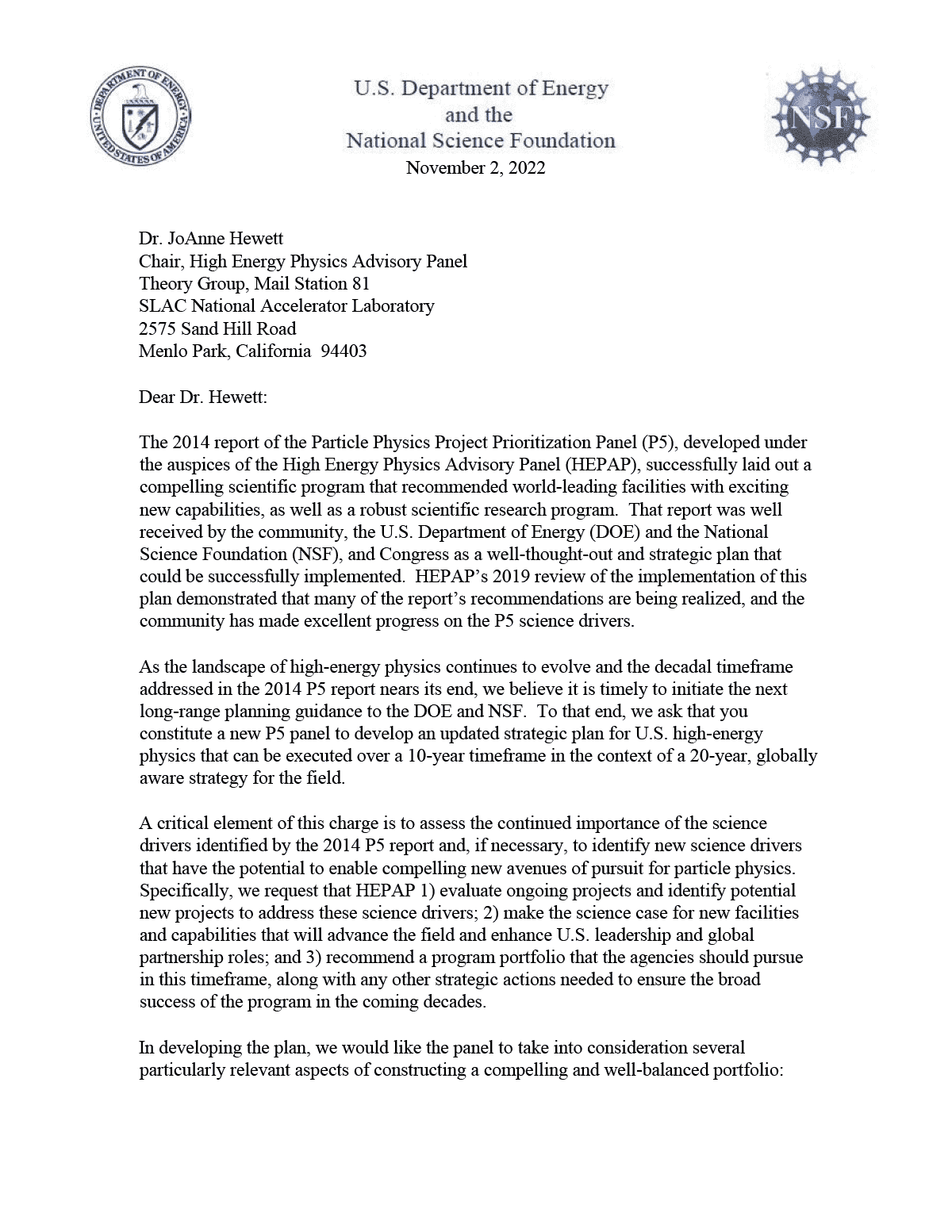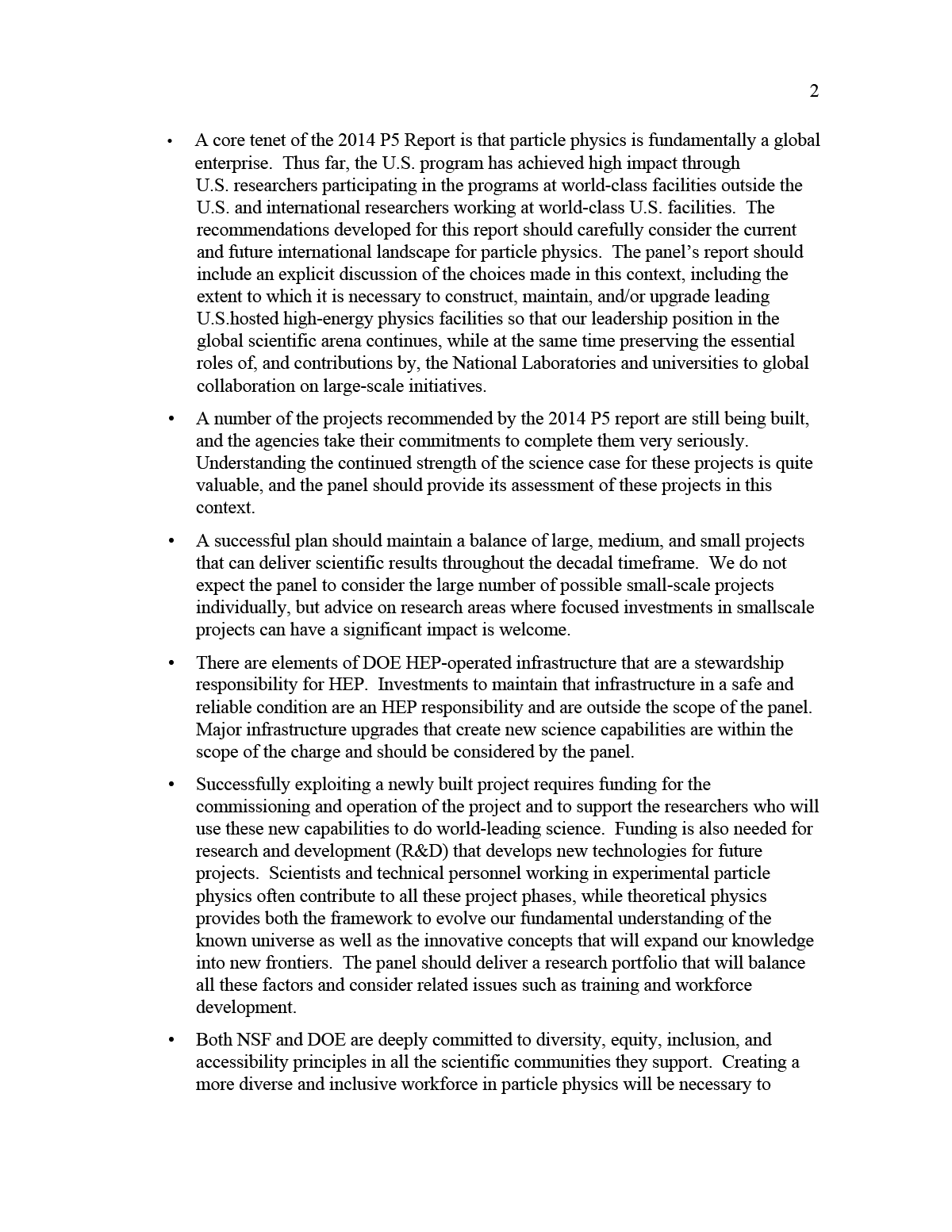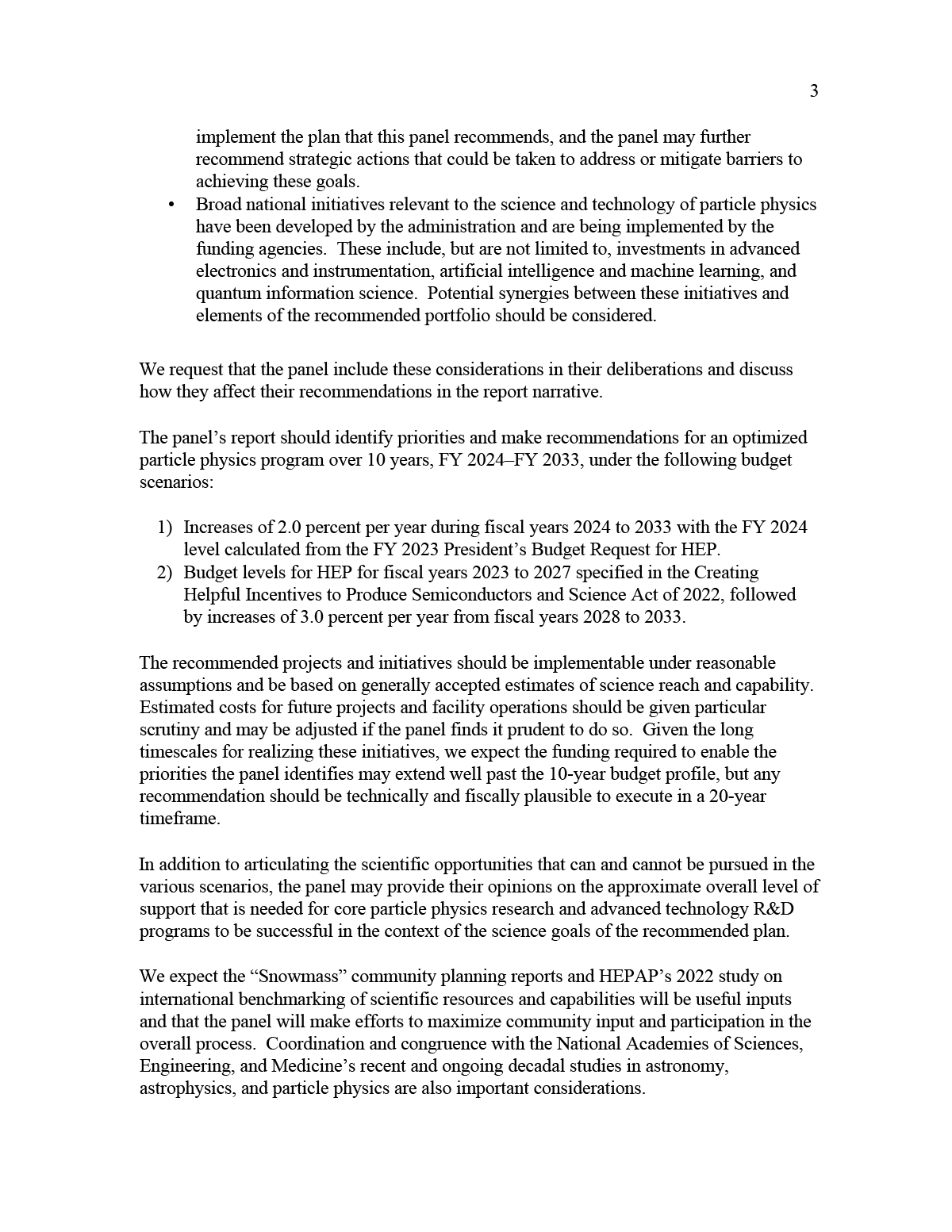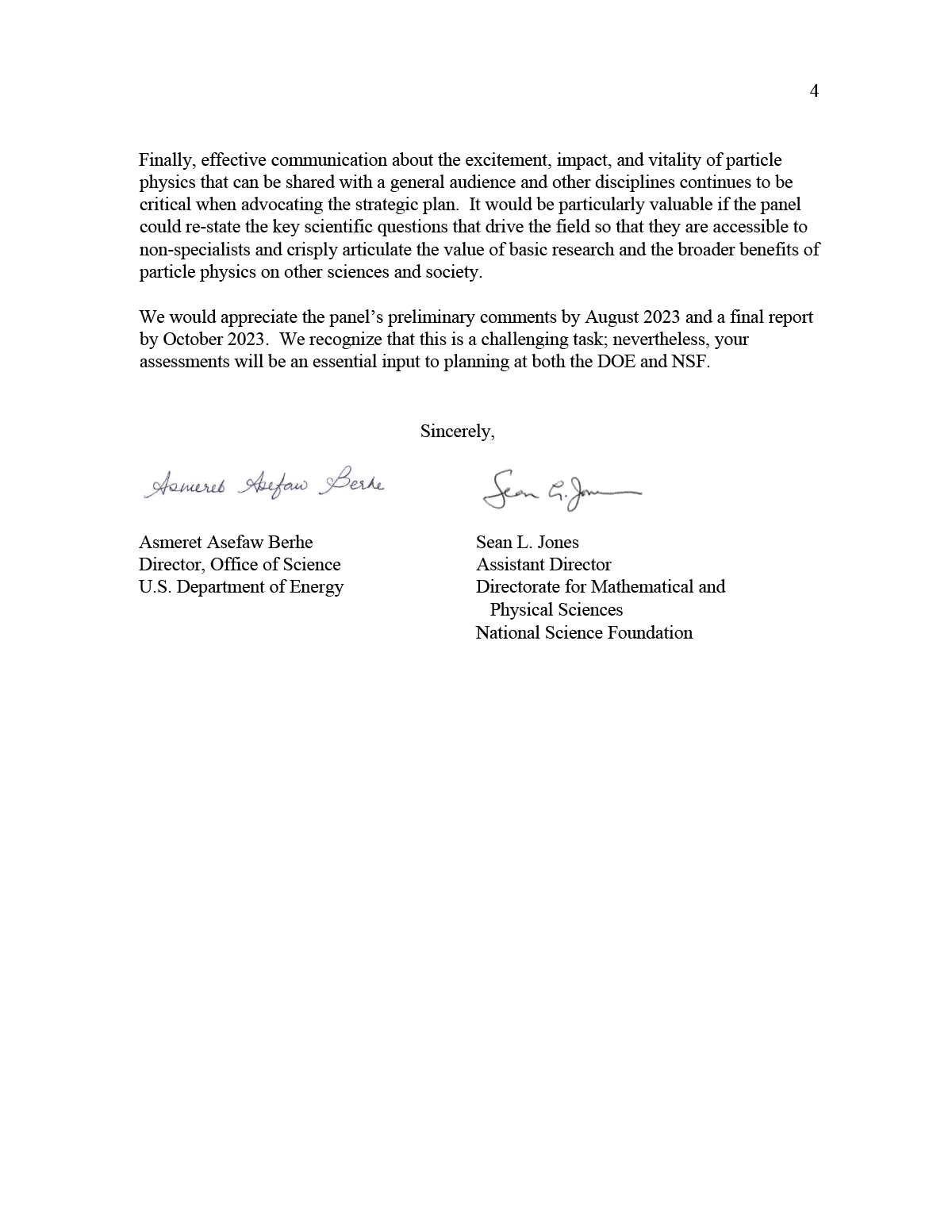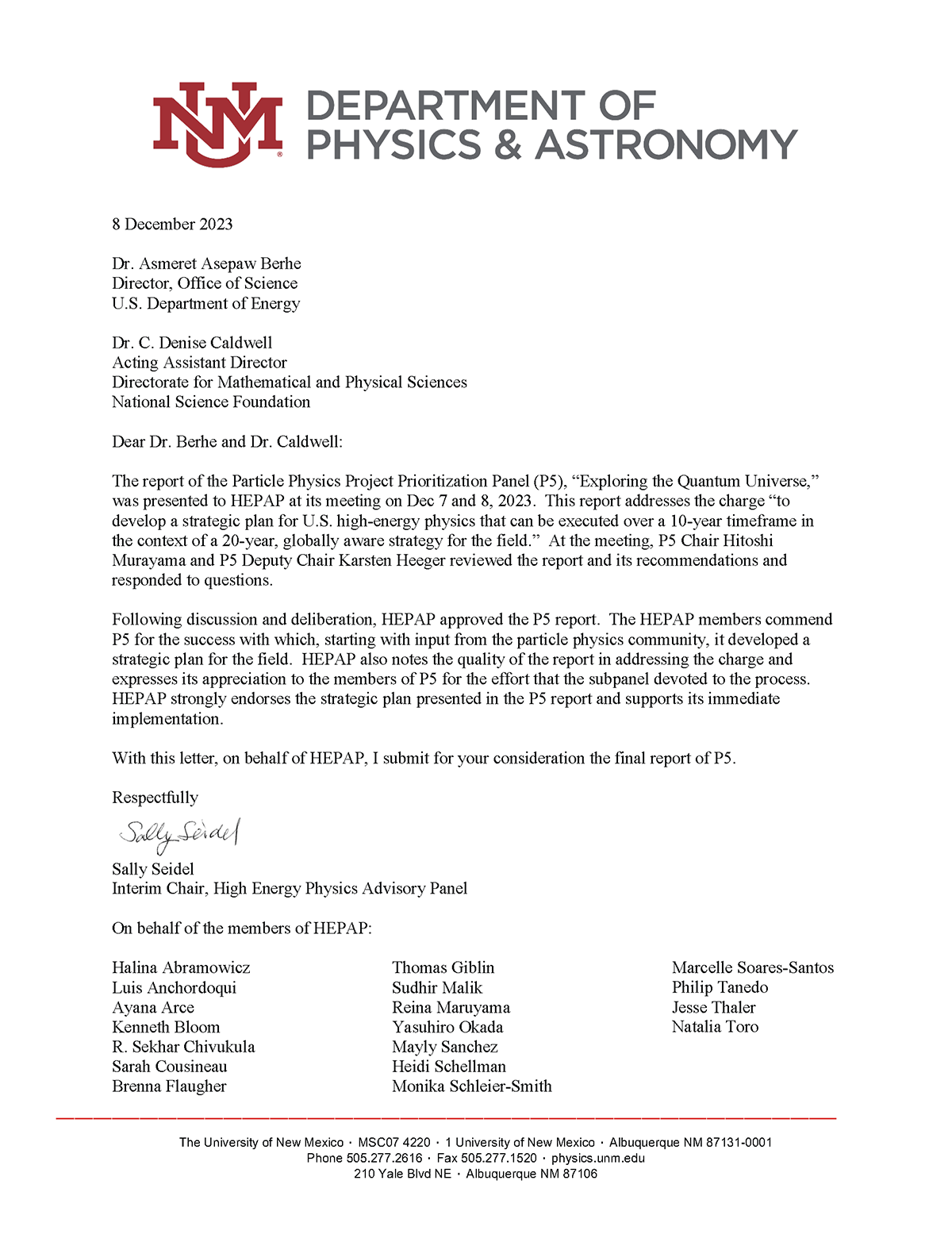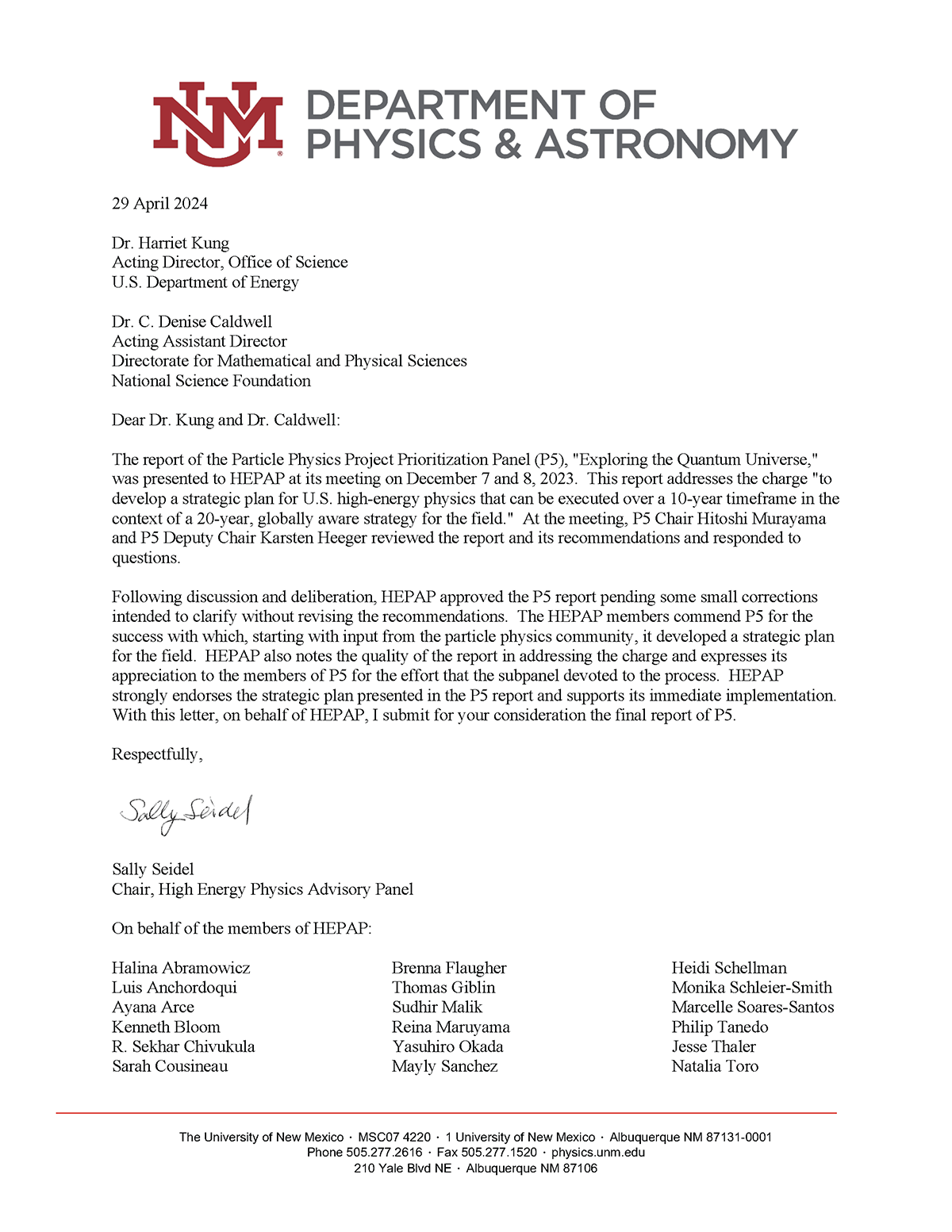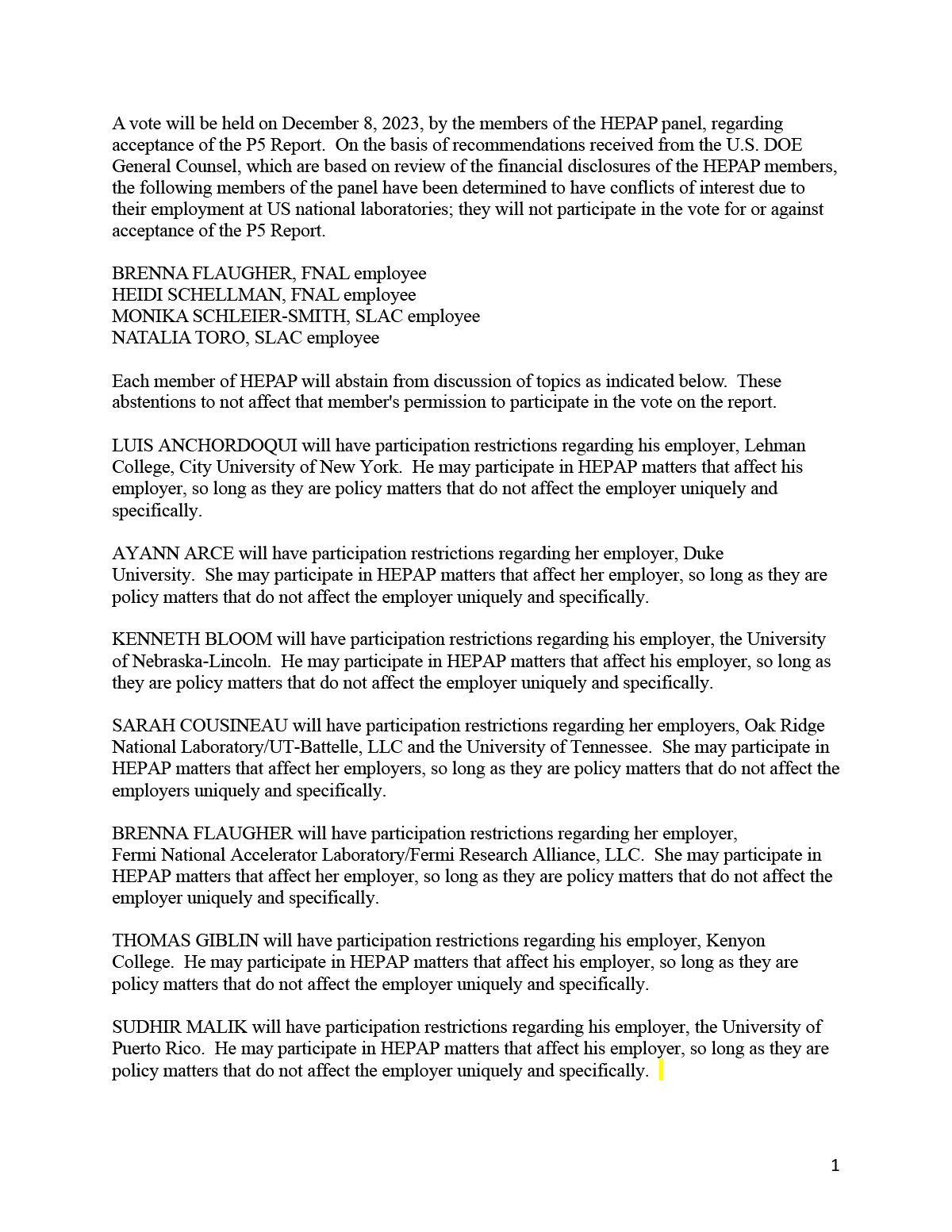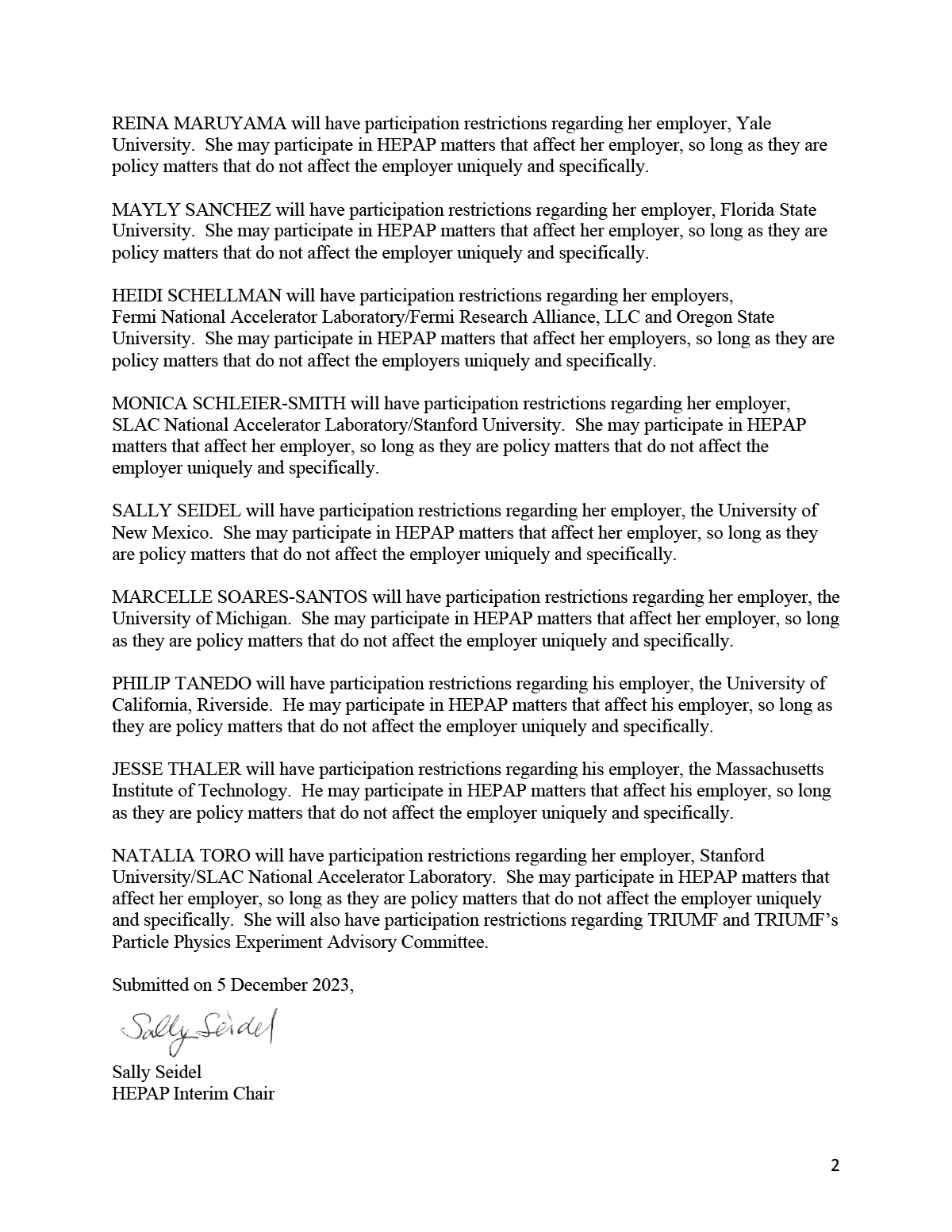Appendix
Appendix
A.1Charge to P5
A.2HEPAP Transmittal Letters
A.3Panel Members
Shoji Asai
University of Tokyo
Amalia Ballarino
CERN
Tulika Bose
University of Wisconsin-Madison
Kyle Cranmer
University of Wisconsin-Madison
Francis-Yan Cyr-Racine
University of New Mexico
Sarah Demers
Yale University
Cameron Geddes
Lawrence Berkeley National Laboratory
Yuri Gershtein
Rutgers University
Karsten Heeger, Deputy Chair
Yale University
Beate Heinemann
DESY
JoAnne Hewett, HEPAP chair,
ex officio until May 2023
SLAC National Accelerator Laboratory
Patrick Huber
Virginia Tech
Kendall Mahn
Michigan State University
Rachel Mandelbaum
Carnegie Mellon University
Jelena Maricic
University of Hawaii at Manoa
Petra Merkel
Fermi National Accelerator Laboratory
Christopher Monahan
William & Mary
Hitoshi Murayama, Chair
University of California, Berkeley
Peter Onyisi
University of Texas at Austin
Mark Palmer
Brookhaven National Laboratory
Tor Raubenheimer
SLAC National Accelerator Laboratory/Stanford University
Mayly Sanchez
Florida State University
Richard Schnee
South Dakota School of Mines & Technology
Sally Seidel, Interim HEPAP chair,
ex officio since June 2023
University of New Mexico
Seon-Hee Seo
IBS Center for Underground Physics,
Fermi National Accelerator Laboratory
Jesse Thaler
Massachusetts Institute of Technology
Christos Touramanis
University of Liverpool
Abigail Vieregg
University of Chicago
Amanda Weinstein
Iowa State University
Lindley Winslow
Massachusetts Institute of Technology
Tien-Tien Yu
University of Oregon
Robert Zwaska
Fermi National Accelerator Laboratory
A.4Process and Meetings
Information gathering phase
February 6, 2023. Kickoff meeting with the Department of Energy (DOE) and the National Science Foundation (NSF)
Open Town Halls, all with short remarks. Live captioning and American Sign Language interpretation was provided at the town halls.
- Berkeley National Lab: February 22, 23. 513 registrants
- Fermilab/Argonne National Lab: March 21, 22, 23. 797 registrants, partially overlapped with Elementary Particle Physics 2024 (EPP2024) town hall
- Brookhaven: April 12, 13. 666 registrants
- SLAC: May 3, 4. 512 registrants. Virtual Town Halls
- University of Texas at Austin: June 5. 159 registrants, exclusive session for early career physicists.
- Virginia Tech, June 27. 119 registrants
Keeping the community informed
- American Physical Society’s (APS’s) Division of Particles and Fields session on P5 (April 15)
- Early Career Network Workshop (June 8,9)
- ACE Science Workshop (June 14,15)
- CEPC Workshop (July 6)
- ICFA (July 15)
- HEPAP (August 7)
- HEP-PI Meeting (August 15)
- CEPC Workshop (October 22)
- ICFA Seminar (November 30)
We used the APS DPF and Division of Physics and Beams mailing lists, Snowmass mailing list, and the P5 website to send out information about the P5 activities.
Deliberation Phase
(closed meetings)
- May 31 to June 2, Austin, TX
- June 21 to 23, Gaithersburg, MD
- July 11 to 14, Santa Monica, CA
- August 1 to 4, Denver, CO
Meetings by working groups, with additional input from the following:
Agencies: Asmeret Berhe, Harriet Kung, Sean Jones, Saúl González, DOE/HEP, NSF/PHY, NSF/AST (Debra Fisher, Nigel Sharp), NSF/OPP (Jim Ulvestad)
Government: Cole Donovan (Department of State, Office of Science and Technology Policy)
Community: International Benchmarking Panel, computing frontier, DPF leadership, previous P5 (Steve Ritz, Andy Lankford), Committee of Visitors’ reports (Ritchie Patterson, Dmitry Denisov)
National Laboratories: Oak Ridge National Laboratory, Thomas Jefferson National Accelerator Facility (Jefferson Lab)
Writing Phase
(Zoom meetings)
- Five full-day meetings (August 11, 18, 25, September 1, 8)
- Short meetings (weekly since September 14)
Peer-Review Process
The draft report was sent to the following people for a peer review on October 25 with a very tight deadline of October 31. We received many invaluable comments. The input and comments we received did not change the contents of the recommendations, but helped us improve the clarity and presentation of our report significantly. Hereby we acknowledge their help.
Elena Aprile
Columbia University
William Barletta
Massachusetts Institute for Technology
John Carlstrom
University of Chicago
Mu-Chun Chen
University of California, Irvine
Sekhar Chivukula
University of California, San Diego
André de Gouvêa
Northwestern University
Josh Frieman
University of Chicago
Elizabeth Hayes
NASA Goddard Space Flight Center
Katrin Heitmann
Argonne National Laboratory
David Hertzog
University of Washington, Seattle
Mark Messier
Indiana University
Laura Reina
Florida State University
Andrei Seryi
Jefferson Lab
Hirohisa Tanaka
SLAC National Accelerator Laboratory
John Womersley
University of Edinburgh
A.5Subcommittee on Cost, Risks, and Schedule
Charge
(March 1, 2023)
The cost/schedule/risk subcommittee to P5 is asked to obtain and clarify the cost, schedule, and risk information from the proponents of high cost (>$250M in FY23$) HEP projects funded or being considered for funding by DOE and/or NSF. The subcommittee will not prepare its own estimates. The subcommittee should assess this information at a high level, noting key assumptions, risks, and cost and schedule uncertainties including the risk from non-DOE/NSF funding sources, international partners making in-kind contributions and collaborations, and missing costly items, if any. The subcommittee is also asked to comment on the operation costs for projects during commissioning and when the resulting facilities are in steady-state operation. This subcommittee will provide P5 with the expert opinions on the uncertainty ranges for the projects that P5 needs in order to develop a strategy for the field within assumed budgetary constraints. The subcommittee will submit their preliminary report to P5 in early summer.
Members
Jay Marx, Chair
California Institute of Technology
Gil Gilchriese, Matthaeus Leitner
Lawrence Berkeley National Laboratory
Giorgio Apollinari, Doug Glenzinski
Fermi National Accelerator Laboratory
Norbert Holtkamp, Mark Reichanadter,
Nadine Kurita
SLAC Accelerator National Laboratory
Jon Kotcher, Srini Rajagopalan
Brookhaven National Laboratory
Allison Lung
Jefferson Lab
Harry Weerts
Argonne National Laboratory
Process
- Single contact person for each project determined
- Set of 20 questions sent to project with answers requested in 1 week
- Divided committee into eight subgroups of three members each with a designated lead for each project
- Each member involved in two of the eight projects
- Possible conflicts of interest taken account in assignment to subgroups
- Assignment matrix
Based on the inputs from the proponents and experience of the subcommittee members, they provided three possible funding and schedule scenarios:
- The low estimate is meant to be possible but optimistic—most things have to go right.
- The mid-range estimate is meant to be moderately probable.
- The high estimate is meant to be pessimistic but not unlikely.
The subcommittee report was received on June 30, 2023.
A.6Important References
Building for Discovery: Strategic Plan for US Particle Physics in the Global Context,
https://www.usparticlephysics.org/2014-p5-report/
HEPAP Assessment of Progress on 2014 P5 Report, (March 2020),
https://science.osti.gov/-/media/hep/hepap/pdf/Reports/HEPAP-Assessment-of-Progress-on-2014-P5-Report-(2020).pdf
The Path to Global Discovery: U.S. Leadership and Partnership in Particle Physics, https://science.osti.gov/-/media/hep/hepap/pdf/202203/International_Benchmarking_HEPAP_2023112.pdf
Report of the Committee of Visitors, Office of High Energy Physics, to the High Energy Physics Advisory Panel, https://science.osti.gov/-/media/sc-2/pdf/cov-hep/2021/HEP_COV_2020_Report.pdf
Report of the 2023 Committee of Visitors, Division of Physics, National Science Foundation, https://www.nsf.gov/od/oia/activities/cov/mps/2023/2023_MPS_PHY_COV_Report.pdf
DOE Basic Research Needs for High Energy Physics—Detector Research and Development, https://www.osti.gov/servlets/purl/1659761
Report of the 2021 U.S. Community Study on the Future of Particle Physics (Snowmass 2021), Summary Chapter, Joel N. Butler et al.,
[https://arxiv.org/abs/2301.06581
The Future of US Particle Physics—The Snowmass 2021 Energy Frontier Report, Meenakshi Narain et al., https://arxiv.org/abs/2211.11084
Snowmass Neutrino Frontier Report, Patrick Huber et al.,
https://arxiv.org/abs/2211.08641
Snowmass Report of the Frontier For Rare Processes and Precision Measurements, Marina Artuso et al.,
https://arxiv.org/abs/2210.04765
Snowmass Cosmic Frontier Report, Aaron Chou et al.,
https://arxiv.org/abs/2211.09978
Snowmass Theory Frontier Report, Nathaniel Craig et al.,
https://arxiv.org/abs/2211.05772
Snowmass’21 Accelerator Frontier Report, S. Gourlay et al.,
https://arxiv.org/abs/2209.14136
Report of the Instrumentation Frontier Working Group for Snowmass 2021, Phillip Barbeau et al.,
https://arxiv.org/abs/2209.14111
The Future of High Energy Physics Software and Computing, V. Daniel Elvira et al.,
https://arxiv.org/abs/2210.05822
Snowmass 2021 Underground Facilities & Infrastructure Frontier Report, Laura Baudis et al.,
https://arxiv.org/abs/2211.13450
Community Engagement Frontier, Ketevi A. Assamagan et al.,
https://arxiv.org/abs/2211.13210
Snowmass Early Career, Garvita Agarwal et al.,
https://arxiv.org/abs/2210.12004
Report of the Snowmass 2021 Implementation Task Force, Thomas Roser et al., https://arxiv.org/abs/2208.06030
2020 Update of the European Strategy for Particle Physics,
https://cds.cern.ch/record/2721370/files/CERN-ESU-015-2020_Update_European_Strategy.pdf
European Astroparticle Physics Strategy 2017–2026, Mid-Term Update 2023,
https://www.appec.org/roadmap
Decadal Survey on Astronomy and Astrophysics 2020 (Astro2020), https://www.nationalacademies.org/ourwork/decadal-surveyon-astronomy-and-astrophysics-2020-astro2020
A New Era of Discovery: The 2023 Long Range Plan for Nuclear Science, https://nuclearsciencefuture.org/
Canadian Subatomic Physics Long-Range Plan,
https://subatomicphysics.ca/
Update of the Japanese Strategy for Particle Physics,
https://www.jahep.org/files/snowmass2021_loi_JapaneseStrategy.pdf
A.7Conflict of Interest Resolution
A.8Acronyms & Glossary
Accelerator: A particle accelerator, which accelerates a beam of particles such as electrons, positrons, muons, or protons.
ACE: Accelerator Complex Evolution. A proposed major upgrade to the accelerator complex at Fermilab.
ACE-BR: Accelerator Complex Evolution Booster Replacement. A proposed major upgrade to the accelerator complex at Fermilab, including a replacement of the booster synchrotron, as part of ACE.
ACE-MIRT: Main Injector Ramp and Target is a proposed upgrade to Fermilab accelerator complex to upgrade the beam to power of 2.1 MW; part of the re-envisioned DUNE Phase II. Included as a component of ACE.
ACORN: Accelerator Controls Operations Research Network (ACORN). A project to modernize accelerator controls at Fermilab.
ADMX: Axion Dark Matter eXperiment. An experiment aiming to detect a hypothetical particle called axion as a candidate of dark matter built at University of Washington, Seattle. Its second generation is called ADMX-G2.
AI/ML: Artificial intelligence/machine learning.
ALP: Axion-like particle. A class of hypothetical pseudoscalar particles, beyond the Standard Model. A generalization of the axion that relaxes the relationship between particle mass and coupling to the Standard Model.
AMF: Advanced Muon Facility. A proposed muon facility at Fermilab to produce bright beams of muons for charged lepton-flavor violation physics and other future experiments.
ANL: Argonne National Laboratory.
ASIC: Application-specific integrated circuits.
ASTAE: Advancing Science and Technology through Agile Experiments. A portfolio of small-scale DOE experiments proposed in this report.
AST: Division of Astronomical Sciences. A division in NSF Mathematical and Physical Sciences focused on astronomical sciences.
AS&T: Accelerator science and technology.
ATLAS: An operating experiment at LHC, CERN. One of the two experiments responsible for the discovery of the Higgs boson in 2012.
Atom interferometer: A quantum sensor that uses a wave-like behavior of atoms. It is used for wave-like dark matter searches.
Atomic clock: A high-precision clock that measures time using the resonant frequency of atoms, the basis of the definition of a second. It is used for dark matter searches through variations in fundamental constants.
Antiparticle: A particle that has the same mass and the opposite electric charge of a given particle.
ATF: Accelerator Test Facility. A user facility at Brookhaven National Laboratory that supports experiments for advanced accelerator and laser research including research on technologies that could make future particle accelerators much smaller.
AUP: High-Luminosity LHC Accelerator Upgrade Project. The accelerator portion of the US contribution to HL-LHC providing critical components such as high-field “triplet” magnets using the Nb3Sn technology.
Automatic differentiation: A set of techniques for evaluating derivatives automatically; widely used for optimization.
AWA: Argonne Wakefield Accelerator Facility. A facility to demonstrate electron-beam-driven wakefield acceleration technologies that could make future particle accelerators much smaller.
Axion: A hypothetical particle postulated to account for the rarity of processes that break charge-parity symmetry. It is very light, electrically neutral, and pseudoscalar.
BELLA: Berkeley Lab Laser Accelerator. A facility at Lawrence Berkeley National Accelerator Laboratory that uses intense lasers to drive wakefields in plasma for research on technologies that could make future particle accelerators 100 to 1,000 times smaller, including combination of successive acceleration stages.
Belle, Belle II: Belle was an experiment that studied the properties of the bottom quark bound states and discovered CP violation in these systems. Belle II is a successor experiment that explores quantum imprints of new phenomena in these systems. Both Belle and Belle II are hosted by KEK, a national accelerator laboratory in Japan.
BES: Beijing Spectrometer. A series of detectors mounted at Beijing Electron Positron Collider (BEPC). Both BEPC and its upgrade, BEPC II, are hosted by Institute of High Energy Physics (IHEP) in China. The current incarnation is BES III, which explores quantum imprints.
BES: Basic Energy Sciences. An office within the DOE Office of Science performing basic science investigations into materials, chemistry, and geoscience.
BICEP: Background Imaging of Cosmic Extragalactic Polarization. An experiment that measures the polarization of Cosmic Microwave Background (CMB) polarization, the oldest light in the Universe, to understand questions about the beginning of the Universe.
Big Bang: The unofficial name for the beginning of the universe as a small patch of space with a huge amount of energy that expanded in an explosive fashion.
BNL: Brookhaven National Laboratory.
Booster: A proton synchrotron accelerator, part of the accelerator complex at Fermilab.
BRN: DOE Basic Research Needs Study for Detectors.
BSM: Beyond the Standard Model. A realm of particle physics not encompassed by the Standard Model of Particle Physics.
CAD: Computer-aided design software. A widely used mechanical engineering design tool.
CCC: Cool Copper Collider, a concept for a future particle accelerator using normal conducting copper accelerators cooled to cryogenic temperatures.
CERN: Conseil Européen pour la Recherche Nucléaire. A European organization for nuclear research situated on the border of Switzerland and France
CEvNS: Coherent Elastic Neutrino Nucleus Scattering. A process of neutrinonucleus scattering in which the nucleus acts like a single particle. First experimentally observed in 2017 by the COHERENT experiment.
CHIPS: Creating Helpful Incentives to Produce Semiconductors (CHIPS) and Science Act of 2022. A new large-scale funding to boost domestic research and manufacturing of semiconductors in the United States.
CLIC: Compact Linear Collider. A proposed accelerator that is being designed as an addition to the CERN accelerator complex.
CMB: Cosmic microwave background, the oldest light in the universe, emitted 380,000 years after the Big Bang. It has become microwave radiation by the expansion of the universe, and it permeates the entire observable universe.
CMB-S4: Cosmic Microwave Background experiment Stage IV. An experiment set to make precision measurements of the polarization of the CMB, the oldest light in the Universe. It will constrain the physics of inflation in the early universe, light relics, and the properties of neutrinos among other science goals. It has two sites, the South Pole site and Atacama desert in Chile.
CMS: Compact Muon Solenoid. An operating experiment performed at the LHC, CERN; one of the two experiments that discovered the Higgs boson in 2012.
Collider: A particle accelerator that accelerates beams of particles in opposite directions and then collides them to achieve very high-energy collisions.
CPAD: The Coordinating Panel for Advanced Detectors. A panel that seeks to promote, coordinate, and assist in the research and development of instrumentation and detectors for high energy physics experiments under the auspices of Division of Particles and Fields, American Physical Society.
CP-violation: Subtle differences between the behaviors of matter and antimatter. Under most circumstances, antimatter behaves almost exactly like matter in the mirror. If that behavior is not the case, it is said that the charge-parity symmetry (CP) is violated.
CTA: Cherenkov Telescope Array. An array of telescopes that study high-energy gamma-rays from the universe. It is under construction on the Canary Islands, Spain, and at Paranal, Chile. The US is a member of the 25-nation consortium.
Dark energy: An unknown form of energy that makes up about 69% of energy in the universe today. Its existence has been inferred from the observation that the expansion of the universe is accelerating today. One possibility is that it is the energy of the vacuum, called the cosmological constant, designated as Λ. Another possibility is that it is the slowly evolving energy density of a field.
Dark matter: An unknown type of matter that makes up 84% of matter in the universe today. Its existence has been inferred from the rotation speed of stars and gas in galaxies, gravitational lensing due to clusters of galaxies, large-scale structure, and CMB measurements. Its gravitational pull was necessary to form stars and galaxies from the primordial gas.
Dark Matter (DM) G2, G3: Generation 2 and Generation 3 dark matter experiments. Generation 2 WIMP-search experiments comprise no more than a few tens of tons of target mass and are currently operating or under construction. Generation 3 WIMP-search experiments will have tens to hundreds of tons of target mass, increasing the WIMP sensitivity to neutrino fog level.
Dark photons: Hypothetical particles from hidden sectors proposed as force carriers similar to photons, but potentially associated with dark matter.
DarkSide-20k: An experiment aiming at direct detection of dark matter, focusing on WIMP dark matter particle search. It is under construction in the Gran Sasso Underground Laboratory in Italy.
DARPA: Defense Advanced Research Projects Agency.
DES: Dark Energy Survey. An experiment that mapped out hundreds of millions of galaxies and detected supernovae, looking for patterns in cosmic structure in order to reveal the nature of the dark energy that is accelerating the expansion of the universe.
DESC: Dark Energy Science Collaboration. A group of scientists that study the nature of dark energy using data from Rubin LSST.
DESI, DESI-II: Dark Energy Spectroscopic Instrument. A spectroscopic galaxy survey at the Mayall 4-meter telescope at Kitt Peak National Observatory, AZ.
DMNI: Dark Matter New Initiatives. A suite of innovative agile dark matter experiments set to search for various forms of dark matter.
DOE: Department of Energy. The DOE’s Office of Science is the largest funding agency for physical sciences, including the Office of High Energy Physics that supports particle physics research.
DUNE: Deep Underground Neutrino Experiment. An experiment that studies the oscillation of neutrinos over 800 miles, a macroscopic quantum phenomenon. The beam of neutrinos is created artificially at Fermilab in Illinois, directed toward Sanford Underground Research Facility in South Dakota, where the neutrinos are detected and studied in the DUNE Far Detectors.
eBOSS: Extended Baryon Oscillation Spectroscopic Survey. A project carried out as part of the Sloan Digital Sky Survey (SDSS-IV) on a 2.5m telescope at Apache Point Observatory, New Mexico.
EDM: Electric dipole moment, a possible interaction of an electric field with spin of an elementary particle. If it exists for an elementary particle, it would break the time reversal symmetry and is a form of CP violation.
EIC: Electron-Ion Collider. A new facility colliding electrons and protons, under construction at BNL in support of the DOE Nuclear Physics program.
FACET-II: Facility for Advanced Accelerator Experimental Tests. An accelerator facility at SLAC National Accelerator Laboratory that provides high-energy electron beams for researching particle accelerator technologies that could make future accelerators 100 to 1,000 times smaller.
FAST: Fermilab Accelerator Science and Technology. A facility including a fully-equipped R&D accelerator chain to support research and development of accelerator technology for the next generation of particle accelerators.
FASER2: Forward Search Experiment at the HL-LHC. A proposed experiment to look for new long-lived particles. It builds on the success of the FASER experiment and is proposed to be housed at the FPF.
FCC: Future Circular Collider. A future particle accelerator complex planned at CERN to support the FCC-ee and FCC-hh in a new underground tunnel with 91 km circumference.
FCC-ee: A proposed electron-positron Higgs factory in the FCC tunnel, possibly an intermediate step toward the FCC-hh collider.
FCC-hh: A proposed proton-proton collider in the FCC tunnel that will push the energy about seven times higher than that of the current LHC.
FD3, FD4: The third and fourth far detector modules of the DUNE experiment, located at the Sanford Underground Research Facility (SURF) in South Dakota.
Fermilab: Fermi National Accelerator Laboratory. A US National Laboratory focused on particle physics research located in Batavia, IL.
FES: Fusion Energy Sciences. An office in the DOE Office of Science performing investigations into fusion energy sources, and the corresponding science of matter at very high temperatures and densities.
Fifth force: A new hypothetical force, beyond the four fundamental forces of nature (gravitational, electromagnetic, weak, and strong force).
FORMOSA: An experiment to search for millicharged particles in the LHC collisions. It builds on the experience of the MilliQan experiment and is proposed to be housed at the FPF.
FPF: Forward Physics Facility. A proposed underground facility to operate several hundred meters away from ATLAS during the LHC-HL running, with several new experiments aligned with ATLAS collision axis.
FPF trio: The bundled request for US funding for three of the proposed experiments at FPF, including FASER2, FORMOSA, and the Forward Liquid Argon Experiment (FLArE).
FY23: Fiscal Year 2023, spanning from October 1, 2022 to September 30, 2023.
GARD: General Accelerator Research and Development program with the DOE Office of High Energy Physics. GARD develops advanced technologies for the acceleration of particles for HEP and other applications.
Dark Matter (DM) G2, G3: Generation 2 and Generation 3 dark matter experiments. Generation 2 WIMP-search experiments comprise no more than a few tons of target mass and are currently operating, or under construction. Generation 3 WIMP-search experiments will have tens to hundreds of tons of target mass, increasing the sensitivity to WIMPs to levels reaching the neutrino fog.
Geometric deep learning: A broad class of machine learning (ML) approaches that take into account symmetries and invariances.
GeV: Giga-electron-volt. A unit of energy that is approximately equal to the proton’s mass times the speed of light squared
(E=mc²).
Graph neural networks: A method in AI inspired by the way the human brain functions, applied to graph represented data.
Gravitational lensing: Focusing of light due to the gravity of mass concentrations bending light such that it is magnified over large distances. Gravitational lensing is used in the investigation of dark matter, dark energy, and other astrophysical phenomena.
Gravitational waves: Ripples of space-time caused by extremely energetic events in the universe such as pairs of black holes or neutron stars that coalesce on inspiraling orbit. Gravitational waves have been recently discovered with terrestrial detectors and are an evolving astrophysical probe of particle physics
HELEN: Higgs-Energy Lepton. An electron-positron linear collider based on advances in superconducting radio frequency technology.
HEP: High Energy Physics. An office in the DOE Office of Science. Sometimes used synonymously with particle physics.
HEPAP: High Energy Physics Advisory Panel. A committee that reports to the Associate Director of DOE HEP and Assistant Director of NSF MPS.
HL-LHC: High-Luminosity LHC. The high luminosity upgrade to Large Hadron Collider
Hidden sectors: Particles and quantum fields described by their mediator particles, that have been hypothesized, but have not been observed yet, possibly due to their small couplings.
Higgs boson: A fundamental particle that is believed to be condensed throughout the universe as the Higgs field, the heart of the Standard Model of particle physics. It is responsible for giving mass to fundamental particles such as quarks and leptons.
Higgs factory: A particle accelerator that collides beams of electrons and positrons, to produce about a million Higgs bosons in order to study the particle’s precise properties.
IceCube: IceCube. An astrophysical neutrino observatory, located at the South Pole, utilizing 1 km3 of Antarctica ice as target for neutrino detection. IceCube has produced a picture of the Milky Way galaxy in neutrinos.
IceCube-Gen2: IceCube-Gen2. A proposed expansion of IceCube that will employ optical and radio detection methods to cover a broad range of neutrino energies.
ICFA: International Committee for Future Accelerators. A body of the International Union of Pure and Applied Physics created to facilitate international collaboration in the construction and use of accelerators for particle physics.
ILC: International Linear Collider. A proposed future electron positron collider using superconducting radiofrequency technology.
ITN: ILC Technology Network. A network of international institutions set to advance ILC-related technology in selected areas toward engineering design and to explore opportunities for other accelerator applications.
IMCC: International Muon Collider Collaboration to internationally develop the R&D and planning as a pathway toward a collider of muons and anti-muons.
Inflation: A period of exponential expansion of the universe in a fraction of a second after the Big Bang. It is hypothesized to have expanded the size of the universe more than a billion trillion times and seeded quantum fluctuations that became stars and galaxies.
INSPIRE: A one-stop information platform for HEP community, comprising eight interlinked databases on literature, conferences, institutions, journals, researchers, experiments, jobs and data. Run in collaboration by CERN, DESY, Fermilab, IHEP, IN2P3, and SLAC, it has been serving the scientific community for almost 50 years.
IOTA: Integrable Optics Test Accelerator ring. The primary focus of the FAST accelerator R&D facility, IOTA is a circular accelerator testing nonlinear and other advanced approaches to particle beam technology.
J-PARC: The Japan Proton Accelerator Research Complex, jointly operated by KEK and the Japan Atomic Energy Association. J-PARC provides proton beams for T2K, COMET, and other particle physics experiments.
kBELLA: A proposed technology test facility of new plasma wakefield acceleration techniques that use high-power lasers to accelerate particles within very short distances.
KEK: High Energy Accelerator Research Organization in Japan, which hosts many particle physics experiments, and co-operates J-PARC with the Japan Atomic Energy Agency.
LAr: Liquid argon (cooled to cryogenic temperatures) used as a detector medium for neutrino, collider, and dark matter experiments
LARP: US LHC Accelerator Research Program. An accelerator research program in US that studied possible improvements on the LHC, which led to AUP.
LArTPC: Liquid argon time-projection chamber, a detector technology for neutron experiments and other particle physics.
LQCD: Lattice quantum chromodynamics. A tool to carry out non-perturbative theoretical calculations to describe properties of hadrons, which are composed of quarks and gluons.
LBNF: Long Baseline Neutrino Facility. A world-class facility hosting the DUNE experiment, and providing the long-baseline neutrino beam.
LBNL: Lawrence Berkeley National Laboratory.
ɅCDM: The current paradigm to describe the evolution of the universe from the Big Bang to today, based on the cosmological constant (Λ, lambda) and cold dark matter (CDM), with fluctuation of densities seeded by inflation.
LCLS: Linac Coherent Light Source. The world’s first hard X-ray free-electron laser located at SLAC National Accelerator Laboratory supported by DOE Basic Energy Sciences.
LCLS-II, LCLS-II-HE: Linac Coherent Light Source-II, and its upgrade. The world’s first MHz rate hard X-ray free-electron laser located at SLAC National Accelerator Laboratory.
Lepton: A collective name for elementary matter particles that do not participate in the strong interaction—namely electron, muon, tau, three neutrinos, and their antimatter counterparts.
LHC: Large Hadron Collider. The world’s largest and highest-energy accelerator, located at CERN, Switzerland.
LHCb: Large Hadron Collider beauty. An experiment that primarily studies systems of bottom quark produced by the collisions in the LHC.
LIM: Line Intensity Mapping. A proposed method to create 3D maps of the universe using emission lines from atoms redshifted to radio signals.
LSND: Liquid Scintillator Neutrino Detector. A completed neutrino-oscillation experiment that reported an anomaly, suggesting existence of more than three neutrino species. Currently tested by SBN experiments at Fermi National Laboratory.
LSST: Legacy Survey of Space and Time. A 10-year survey that the Vera C. Rubin Observatory will carry out.
LZ: LUX-ZEPLIN. An experiment for direct detection of dark matter at SURF, searching for WIMPs. It is a TPC filled with 7,000 kg of liquified xenon.
MagLab: The national High Magnetic Field Laboratory at Florida State University.
Magnetometer: A device that precisely measures magnetic field and magnetic dipole moment.
MATHUSLA: Massive Timing Hodoscope for Ultra Stable neutraL pArticles. A proposed surface detector at HL-LHC, searching for hypothetical neutral Long Lived Particles (LLPs).
MCND: More Capable Near Detector. An upgraded DUNE Near Detector that is part of DUNE reinvisioned Phase II.
MPS: Directorate of Mathematical and Physical Sciences, within National Science Foundation (NSF).
MRI: Major Research Instrumentation program. An NSF funding program for multi-user research instruments up to $4M.
MSRI: Mid-Scale Research Infrastructure. An NSF funding program to build experiments and facilities in the cost range of $4–20M (MSRI-1) or $20–100M (MSRI-2) (information for FY2023).
Muon collider: A circular particle accelerator that steers and collides beams of muons and anti-muons.
Mu2e, Mu2e-II: Muon to electron conversion experiment and its proposed upgrade, stationed at Fermilab, set to search for physics Beyond Standard Model.
Muon g-2: An experiment at Fermilab that performed the most precise measurement of the muon anomalous magnetic moment.
MW: Megawatt, a unit of power equal to one million watts, used to measure proton beam power as the production of protons per second, and the total energy per proton.
Nanofabrication: Manufacturing materials at the nanometer scale.
NASA: National Aeronautics and Space Administration.
Nb₃Sn: Niobium Three Tin. A superconducting material characterized by the ability to sustain high currents and magnetic fields; used in particle accelerators such as HL-LHC and nuclear magnetic resonance.
New physics: Phenomena that cannot be described by the currently known laws of physics, such as the Standard Model of particle physics or ɅCDM model of cosmology.
Neutrino: The most abundant known massive fundamental particles, a billion times more abundant than particles that make up the matter that surrounds us. Neutrinos are neutral, weakly interacting, and extremely light. They rarely interact with matter, so intense sources or huge detectors are required in order to observe their interactions and study their properties.
Neutrino fog: An irreducible background for WIMP dark matter search due to neutrino interactions in the dark matter detectors that mimic the WIMP signals. Due to the extremely small probability of neutrino interaction, only the G3 dark matter detectors will be large enough to start seeing neutrino interactions from the atmospheric neutrino flux passing through detectors.
Neutrino Platform: CERN’s main contribution to a globally coordinated program of neutrino research, providing access for European researchers. It includes provision of an R&D facility at CERN to develop and prototype the next generation of neutrino detectors, including Icarus, Baby MIND and ProtoDUNE. It also includes direct contributions to experiments, such as the cryostats for the DUNE detectors.
NNSA: National Nuclear Security Agency, a component of the USA Department of Energy.
NOvA: NuMI Off-axis ve Appearance. A long baseline neutrino oscillation experiment, operating in Ash River, Minnesota, detecting the neutrino beam sent from Fermilab, 500 miles away.
NSAC: Nuclear Science Advisory Committee. An advisory committee that provides official advice to the Department of Energy (DOE) and the National Science Foundation (NSF) on the national program for basic nuclear science research.
NSF: National Science Foundation. A USA federal funding agency for basic and applied science.
NSF/PHY: Division of Physics within the NSF directorate of Mathematical and Physical Sciences (MPS).
nuSTORM: Neutrinos from Stored Muons. A proposed facility that can provide electron- and muon-neutrino beams from the decay of low-energy muons confined within a storage ring.
Offshore: Located outside the United States.
Onshore: Located on the territory of the United States.
OPP: Office of Polar Programs, a program of the National Science Foundation, responsible for the logistics and much of the operations of South Pole Station.
ORISE: Oak Ridge Institute for Science and Education. Office that provided logistical support for P5 panel meetings and travel needs.
P5: Particle Physics Project Prioritization Panel, jointly commissioned by DOE and NSF, under the auspices of HEPAP, to develop a detailed strategic plan for US particle physics over the next 10 years, with a 20-year vision.
PDG: Particle Data Group. An international collaboration that publishes a biannual compilation of important data in particle physics based in Lawrence Berkeley National Laboratory.
Parton: Point-like, seemingly fundamental, constituent of a hadron (a composite particle consisting of two or more quarks held together by a strong force). Sometimes also used to describe other fundamental particles.
Positron: Anti-electron. A positively charged elementary particle with mass identical to an electron. It is an antiparticle to the electron.
pCM: Parton center-of-momentum. A measure of how much energy is available for the creation of heavy particles in particle collisions. For elementary particle collisions, such as between an electron and positron, the parton center-of-momentum and beam center-of-momentum are essentially the same. For composite particle collisions, like those between protons, the parton center-of-momentum is substantially lower than the beam center-of-momentum because the actual collisions are of the partonic constituents (quarks and gluons in the case of protons).
PIP, PIP-II: Proton Improvement Plan and its successor. An enhancement to the Fermilab accelerator complex, powering the world’s most intense high-energy neutrino beam.
Plasma wakefield: A technology developed for compact, high-gradient accelerators whereby a witness bunch is accelerated by the oscillating electric field in a plasma, which is created by other particle or laser beams.
ProtoDUNE: Kiloton-scale prototype LArTPC detectors that serve as technology demonstrators for DUNE Far Detectors and are roughly one-tenth the size of far detectors generally. ProtoDUNE detectors are part of the CERN Neutrino Platform program.
QCD: Quantum chromodynamics. A theory of strong interaction between quarks, mediated by particles called gluons.
QIS: Quantum information science, technologies for computation, information processing, and detection that elude classical limitations through the use of quantum effects.
Quantum calorimeter: A quantum sensor for thermal measurement of quanta of energy for dark photon, dark matter, and other hidden sector searches.
Quark: A collective name for elementary matter particles that do participate in the strong interaction—namely, up, down, strange, charm, bottom, and top quark, and their antimatter counterparts.
R&D: Research and development. Efforts to develop technology and techniques for new experiments and facilities that extend capability, reduce costs, or reduce risk.
RDCs: Research and development collaborations, which develop technologies and techniques for future experiments.
RF: Radio frequency, a portion of the electromagnetic spectrum ranging from kHz to GHz. In particle physics, RF is used to directly accelerate particles and as a detection technique.
RHIC: Relativistic Heavy Ion Collider, particle collider, currently operating at Brookhaven National Laboratory.
Rubin: Vera C. Rubin Observatory. An 8m telescope built on Cerro Pachón ridge in Chile which will perform the LSST.
SLAC: SLAC National Accelerator Laboratory.
Snowmass: A scientific study conducted by the particle physics community to plan a scientific vision for the future.
SBN: Short Baseline Neutrino Program is an experimental program at Fermilab.
SNB: Supernova neutrino burst, a phenomenon in which many neutrinos are produced in a short period of time before a supernova explosion occurs.
SNOLAB: A deep underground research laboratory, located near Sudbury, Ontario Canada.
Spec-S5: A proposed Stage-V ground-based spectroscopic experiment to measure inflation parameters and dark energy from medium galaxy redshifts. It follows the Stage-IV DESI experiment.
srEDM: Electric Dipole Moment using Storage Rings. A proposed experiment to measure EDM of protons using an electrostatic storage ring.
SRF: Superconducting radio-frequency, also SCRF, where the RF resonators are fashioned of superconducting materials, such that the energy dissipation is lowered.
SURF: Sanford Underground Research Facility. An underground research facility hosting a suite of experiments for rare event searches including DUNE, located in Lead, South Dakota.
SuperCDMS: Super Cryogenic Dark Matter Search experiment, currently under construction at SNOLAB, is set to search for low mass WIMPs.
SuperKEKB: An electron-positron collider located at KEK, Tsukuba Japan.
SWGO: The Southern Wide-field Gamma-ray Observatory. A ground-based gamma-ray detector for the mapping of large scale emission, as well as providing access to the full sky for transient and variable multi-wavelength and multi-messenger phenomena.
Synchrotron: A type of circular particle accelerator in which the resonant radio frequency is synchronized to the changing velocity of the particles.
T2K: Tokai to Kamioka. A long baseline neutrino experiment operating in Japan. A neutrino beam is sent from the J-PARC proton accelerator facility of Japan to the Super-Kamiokande detector in the Kamioka mine over a distance of 295 km.
TeV: Tera-electron-volt. A unit of energy that is 1000 times larger than a GeV, or giga electron volt.
TPC: Time projection chamber. A type of tracking detector of particles. It drifts ionization electrons to the end of the chamber by a uniform electric field and measures the distance from the end plates by the drift time.
WIMP: Weakly interacting massive particle. One of the most promising dark matter candidates.
XENON-nT: An direct detection dark matter experiment, focusing on WIMP dark matter particle search. It is operating in the Gran Sasso Underground Laboratory in Italy.
ZEUS: Zettawatt-Equivalent Ultrashort pulse laser System, a facility at the University of Michigan that uses intense lasers to drive high intensity science including wakefields in plasma and research on technologies that could make future particle accelerators 100 to 1,000 times smaller.

